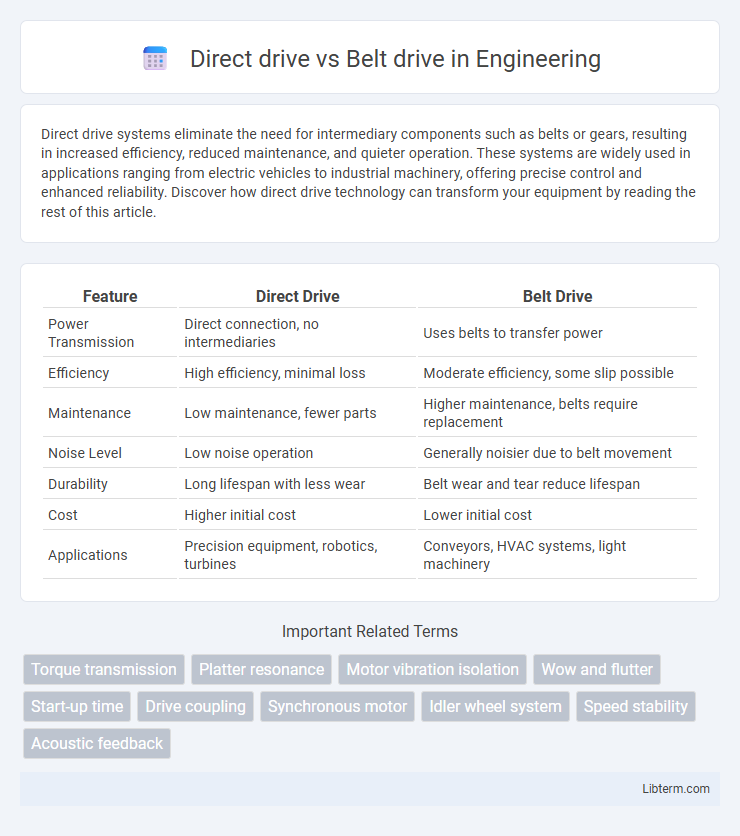Direct drive systems eliminate the need for intermediary components such as belts or gears, resulting in increased efficiency, reduced maintenance, and quieter operation. These systems are widely used in applications ranging from electric vehicles to industrial machinery, offering precise control and enhanced reliability. Discover how direct drive technology can transform your equipment by reading the rest of this article.
Table of Comparison
| Feature | Direct Drive | Belt Drive |
|---|---|---|
| Power Transmission | Direct connection, no intermediaries | Uses belts to transfer power |
| Efficiency | High efficiency, minimal loss | Moderate efficiency, some slip possible |
| Maintenance | Low maintenance, fewer parts | Higher maintenance, belts require replacement |
| Noise Level | Low noise operation | Generally noisier due to belt movement |
| Durability | Long lifespan with less wear | Belt wear and tear reduce lifespan |
| Cost | Higher initial cost | Lower initial cost |
| Applications | Precision equipment, robotics, turbines | Conveyors, HVAC systems, light machinery |
Introduction to Direct Drive and Belt Drive Systems
Direct drive systems transmit power directly from the motor to the load, eliminating intermediary components and resulting in higher efficiency and reduced maintenance. Belt drive systems use belts and pulleys to transfer motion, offering flexibility in distance and torque adjustment but requiring more upkeep due to belt wear. Choosing between direct drive and belt drive depends on factors like torque requirements, space constraints, and maintenance capabilities.
How Direct Drive Works
Direct drive systems connect the motor directly to the load, eliminating intermediary components like belts or gears, which reduces energy loss and mechanical wear. The motor's rotor is attached straight to the driven part, allowing precise control, higher torque at low speeds, and greater efficiency. This configuration enhances performance in applications such as turntables, washing machines, and electric vehicles by providing smooth, quiet operation and improved durability.
How Belt Drive Works
Belt drive systems operate by transmitting power through a flexible rubber or synthetic belt looped around pulleys connected to the motor and the driven component. The belt's tension and friction enable smooth torque transfer, absorbing vibrations and reducing noise compared to direct drive systems. Commonly used in industrial machinery and household appliances, belt drives offer advantages in shock absorption and cost-effectiveness while requiring periodic maintenance to adjust belt tension and prevent slippage.
Key Differences Between Direct Drive and Belt Drive
Direct drive systems feature a motor connected directly to the load, offering higher efficiency, lower maintenance, and reduced noise levels compared to belt drive systems, which rely on belts to transfer power between shafts. Belt drives provide flexibility in distance between motor and load, ease of installation, and cost-effectiveness but can suffer from belt wear, slippage, and periodic maintenance. Key differences include power transmission method, maintenance requirements, efficiency, noise generation, and suitability for varying torque and speed applications.
Efficiency and Performance Comparison
Direct drive motors deliver higher efficiency by eliminating energy losses typically caused by belt slippage and friction, resulting in more precise power transfer and reduced maintenance needs. Belt drive systems often experience decreased performance due to belt wear, tension variations, and increased mechanical complexity, leading to lower overall efficiency and potential power loss. In industrial applications, direct drive is preferred for its superior torque control, consistent speed regulation, and enhanced durability under heavy-duty operations.
Maintenance and Longevity
Direct drive systems require minimal maintenance due to fewer moving parts and lack of belts that wear out or stretch, leading to enhanced reliability and longer lifespan. Belt drive systems need regular belt inspections and replacements to prevent slippage and performance degradation, which can increase maintenance costs and downtime. The durability of direct drive motors often surpasses belt drives, making them more suitable for applications demanding consistent, long-term operation with reduced upkeep.
Noise Levels and Vibration
Direct drive turntables produce significantly lower noise levels and minimal vibration due to the motor being directly connected to the platter, eliminating belt slack and reducing mechanical interference. Belt drive systems, while often praised for isolating motor noise by using a flexible belt, can exhibit higher vibration if the belt wears or stretches, leading to audible hum and resonance. Audiophiles prefer direct drive for consistent sound clarity and reduced acoustic interference in sensitive listening environments.
Cost Implications
Direct drive systems typically have higher upfront costs due to advanced technology and fewer moving parts, reducing maintenance expenses over time. Belt drive systems offer lower initial investment but incur ongoing costs from belt replacements, tension adjustments, and potential downtime. Evaluating total cost of ownership reveals direct drive as more cost-effective for long-term applications despite greater initial expenditure.
Applications: Where Each System Excels
Direct drive systems excel in applications requiring high precision and torque, such as industrial robotics, CNC machines, and hard disk drives, due to their minimal backlash and maintenance-free operation. Belt drive systems are preferred in automotive engines, conveyor belts, and HVAC units for their cost-effectiveness, flexibility, and vibration dampening capabilities. Selecting between direct and belt drive depends on factors like load requirements, speed, noise reduction, and environmental conditions.
Choosing the Right Drive System: Factors to Consider
Selecting the right drive system depends on factors such as noise levels, maintenance requirements, and torque performance. Direct drive systems offer high torque and low maintenance with quieter operation, ideal for precise applications, while belt drive systems provide cost-effectiveness and easier repairability but may suffer from belt wear and higher noise. Evaluating application-specific needs like load capacity, speed consistency, and durability ensures optimal performance and longevity.
Direct drive Infographic

 libterm.com
libterm.com